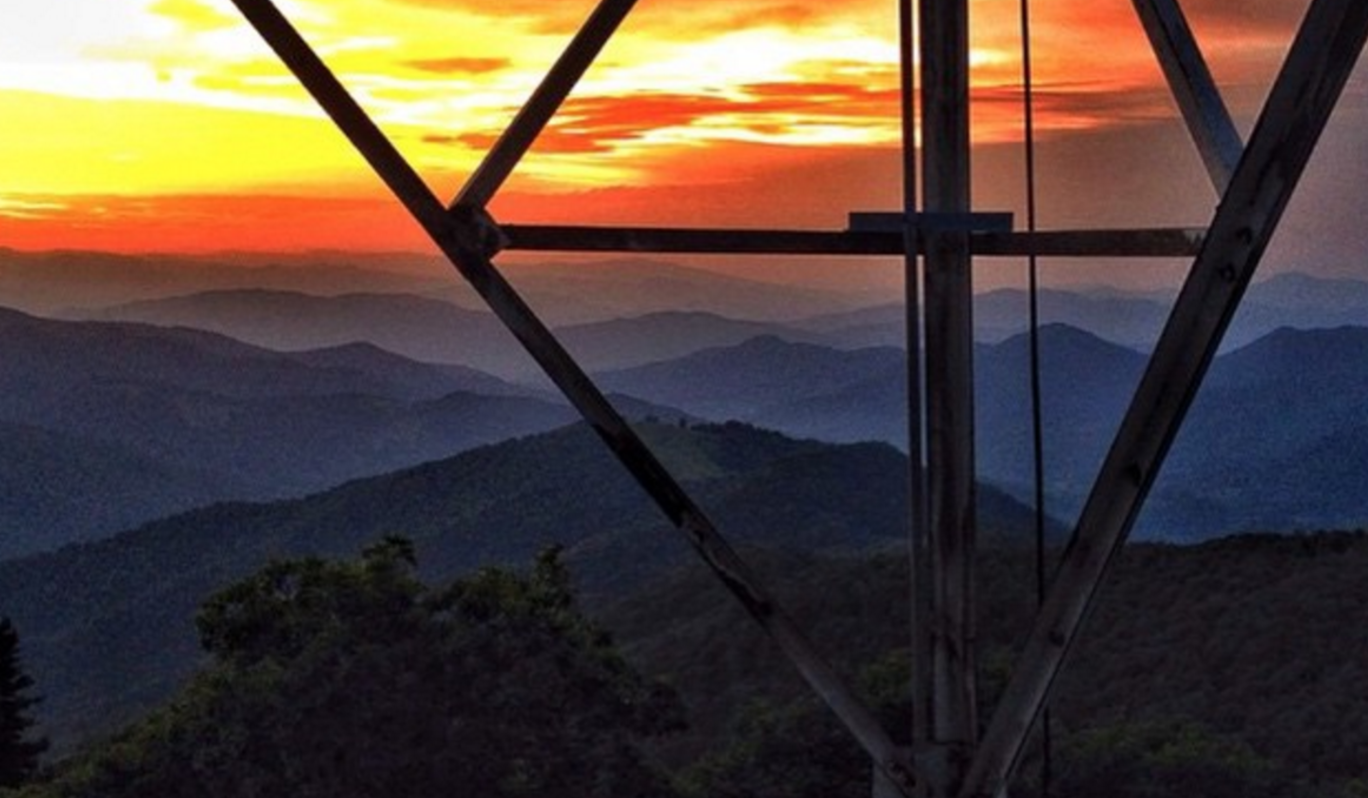Imagine living inside a 40-square-foot room, perched 60 feet above a 5,000-foot mountain for weeks at a time.
Except for the occasional hike to the nearest town for re-supplies, you’re completely self-sufficient. Your job is simple: Watch the mountains that spread before you for smoke. Aside from that basic task, you’re free. It’s just you, the fire tower you call home, and the miles and miles of unending mountains that surround you in every direction.
It’s easy to romanticize the bygone era of fire towers and the watchers who inhabited them, but the truth is, these men and women served a very practical function. At one time, thousands of towers stretched across America’s expansive wilderness. They were manned by watchers who kept tabs on the thunderstorms and accidents that could endanger the forests and communities within their purview.
While some fire towers are still used to monitor the forests in the Western U.S., here in the Southeast, most towers were abandoned in the 1960s when it was decided planes could monitor the mountains more cheaply than men and women living in towers. Since the structures were abandoned almost five decades ago, various land management agencies have either dismantled the majority of their towers or let them fall into disrepair. Virginia’s George Washington National Forest had 24 fire towers at one time; they now have three. The others were either dismantled and sold, moved to private land, or burned by arsonists (a common fate for fire towers).
“Most people think that because these towers are in a national park or in a national forest that they’re maintained by the land managers, but they usually aren’t,” says Peter Barr, author of the book Hiking North Carolina’s Lookout Towers. Barr and the Forest Fire Lookout Association are leading the charge to restore what remains of the Southeast’s lookout towers, partly because of each tower’s historical significance (most were built in the 1930s by the Civilian Conservation Corps), but also because the few towers that remain have become hiking destinations.
“You can hike to the top of a mountain in the Southern Appalachians and you’re not always guaranteed a view,” Barr says. “But if there’s a tower, a 360-degree view is your reward.”
The Forest Service in the Southern Appalachians is beginning to value the towers because they are becoming popular hiking destinations. Cherokee National Forest in Tennessee recently restored the Pinnacle Mountain Tower outside of Erwin, and North Carolina has asked for federal funds to replace the roofs of eight towers in Pisgah and Nantahala National Forests.
During peak foliage season, these towers offer a bird’s eye view of the colorful transition that consumes the Southern Appalachians. Keith Argow, chairman of the Forest Fire Lookout Association and former administrator for the Mount Rogers National Recreation Area, believes these towers offer a unique way for hikers to connect with the forests they overlook.
“These towers are a recognized symbol of our forest legacy—a symbol that helps remind the public that these forests are essential to our environmental well-being.”
High Knob Tower
George Washington National Forest, Va.
The Tower: One of only three fire towers left in the George Washington National Forest, High Knob sits on the state line between Virginia and West Virginia in Rockingham County. It was built by the CCC in ’39, and is one of the few rock towers in the Virginia forest system. A restoration effort between 2001 and 2003 has helped High Knob become one of the most beloved hiking destinations in the G.W. National Forest. A separate tower located in Wise County, Va. was also named High Knob. Sadly, the High Knob Tower in Wise County was burned by an arsonist in 2007. Efforts to restore the tower are underway.
The Hike: Take the two-mile High Knob Trail, which follows the ridgeline of Shenandoah Mountain before accessing the tower. Portions of the trail are steep, but also steeped in rich fall color. Access the trail from Brandywine Campground.
The View: The tower sits at 4,107 feet. From the observation deck, you can see Cow Knob ten miles to the north, Harrisonburg to the east, Reddish Knob to the south, and Spruce Knob in West Virginia to the west.
The Foliage: The slopes immediately surrounding the tower are dominated by colorful hardwoods, as are the forests that unfold before you for 360 degrees.
Hanging Rock Tower
Jefferson National Forest, W.Va.
The Tower: Hanging Rock is a cedar cabin sitting on top of rocky Peters Mountain near the Virginia and West Virginia border. Birding groups use it to spot bald eagles, hawks, falcons, and osprey. In fact, it’s now known as the Hanging Rock Raptor Observatory. The tower burned down in 1996, but the forest service scrambled to rebuild it because it’s so popular with birders.
The Hike: An easy one-mile hike on the Allegheny Trail takes you to the Hanging Rock Tower. Access the Allegheny from the trailhead on Route 15 near Waiteville, W.Va.
The View: Sitting at 3,812 feet, views from the squat tower include the Greenbriar Valley and the Mountain Lake Wilderness as it stretches into Virginia. Beneath your feet lie mountains interspersed with small farm communities.
The Foliage: Peters Mountain is a rocky ridge adorned with mature hardwoods. Reds and yellows creep up to the jagged rock fins that highlight Peters Mountain below the observation deck.
Mount Sterling Fire Tower
Great Smoky Mountains National Park, N.C.
The Tower: Mount Sterling Tower is a 60-foot tall, metal and wood observation deck perched above a dozen flights of stairs. The Mount Sterling Tower was manned several months out of the year by watchers who lived in a nearby cabin for two-week tours. Sterling is one of only three towers left inside the park, and is the highest true fire tower in the eastern U.S. Built in 1935, Sterling hasn’t been maintained since the ‘60s. It was listed on the National Historic Lookout Register in 2007 and is on the waiting list to be rehabbed by the park and the Forest Fire Lookout Association.
The Hike: There are several ways to reach Mount Sterling. One of the most rewarding is to hike the Baxter Creek Trail, which is a 6.1-mile climb from the Big Creek Campground. The trail climbs 4,000 feet in just over six miles, earning the highest average grade per mile of any trail inside the Smokies. Good campsites sit near the base of the fire tower, making Sterling a popular overnight destination.
The View: From its perch at 5,842 feet, you’ll get uninterrupted views of the east end of the park. You can see Balsam Mountain to the west, Mount Guyot to the north, Max Patch to the east, and Cataloochee Valley to the north.
The Foliage: The peak is covered in a dense evergreen forest, so don’t expect close up foliage views from the summit. Once on the tower, the valleys and peaks surrounding you form a undulating sea of color.
Yellow Mountain Tower
Nantahala National Forest, N.C.
The Tower: Yellow Mountain isn’t so much of a tower as it is a tall stone cabin with an observation deck on top. Built in 1934 by the CCC, the cabin was staffed until 1969. It was recently restored, but it sits on the edge of the forest boundary and is being encroached upon by private developments.
The Hike: Take the Yellow Mountain Trail for a 4.9-mile hike with stellar views and a steep climb up Shortoff Mountain. Access the trail from Cody Gap on Buck Creek Road a few miles from Highlands, N.C.
The View: From its observation deck over 5,000 feet above sea level, you can see the rocky cliffs of Hogback Mountain, the Great Smoky Mountains National Park, the 6,000-footers of the Plott Balsams and Great Balsams, and even Lake Jocassee in South Carolina.
The Foliage: Yellow Mountain is a rocky knob with low-lying hardwoods at the base of the tower, so you not only get the long range foliage views, you get some up-close color as well.
Olson Tower
Monongahela National Forest, W.Va.
The Tower: The Olson Tower sits on top of Backbone Mountain, the site of West Virginia’s first fire tower, constructed in 1922. The original tower was removed and replaced by the Olson Tower in 1963. Today, hikers can still climb the steel tower’s 133 steps to the base of the vintage (read: not maintained) cabin.
The Hike: A number of trails lead to Olson Tower, but we like the three-mile Canyon Rim Trail for the full experience. It’s a rocky path starting on Forest Service Road 18 that traverses the northwest side of Blackwater Canyon, delivering you from a thick canopy to the open views from the tower.
The View: The tower sits at 3,736 feet, with views of the Otter Creek Wilderness, Canaan Mountain, Blackwater Canyon, and the Mount Storm Power Station.
The Foliage: You’re immediately surrounded by red spruce, but from the top of the tower you’ll get long-range views of colorful oak, maple, and yellow poplar juxtaposed with sharp green spruce.
Still Watching After All These Years
The Southern Appalachians may be patrolled for fires by planes, but two fire towers in North Carolina are still manned for a few months each year, usually during the winter: Toxaway Tower near Lake Toxaway and Chambers Tower, near Waynesville. A few fire towers in Virginia are also manned on a periodic basis.
“We still need to man fire towers on certain days, especially during windy or inclement weather when planes can’t fly,” says Keith Argow of the Forest Fire Lookout Association. “You need someone with eyes on the forest. And you still need experienced eyes in the towers that can tell the right people exactly where the fire is and which direction it’s moving. There have been several horrible fires out West that could have been contained if someone with experience was watching them.”
Save Shuckstack
The Shuckstack Lookout Tower sits less than a mile off the Appalachian Trail in the southwestern corner of the Great Smoky Mountains National Park. You can see the 60-foot wood and steel tower as you walk across Fontana Dam, and it’s become a prime destination for day hikers and A.T. thru-hikers who use the tower to soak up views of Fontana Lake below. While that view is impeccable, the tower itself has fallen into disrepair. The rotted floor, missing steps, and lack of handrail could pose a hazard to hikers.
“Shuckstack is in great need of repair, but it’s still salvageable,” says Peter Barr. “If we don’t act quickly though, it will become too expensive to repair and the park will shut off access.”
Barr is organizing a project to raise private funds and volunteer labor to restore the tower, hoping that the National Park Service will match the funds and labor as they did to restore the Mount Cammerer Tower in the 1990s. The tower has offered fire protection for the forests and communities of southwestern North Carolina since 1934. Watchers stationed at Shuckstack witnessed the creation of Fontana Dam and the subsequent flooding of the Tennessee River.








